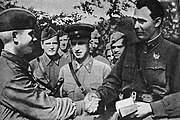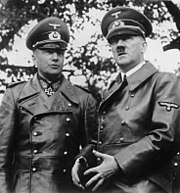
Brigade commissar Leonid Brezhnev (right) giving a Communist party membership card to a soldier (1942)
The Commissar Order (German language: Kommissarbefehl) was an order issued by Adolf Hitler in March 1941, before Operation Barbarossa. Its official name was Guidelines for the Treatment of Political Commissars (Richtlinien für die Behandlung politischer Kommissare). It demanded that any Soviet political commissar identified among captured troops be summarily executed as an enforcer of the Communist ideology and the Soviet Communist Party line in military forces.
According to the order, all those prisoners who could be identified as "thoroughly bolshevized or as active representatives of the Bolshevist ideology" should also be killed.[1]
History[]

Von Brauchitsch with Adolf Hitler in Warsaw – October 1939
Hitler first issued the order at a meeting of the commanders of the three armed services and the key Army commanders for the operation in March 1941. He argued that the war against the Soviet Union "cannot be conducted in a knightly fashion" because it was a war of "ideologies and racial differences." He further declared that the commissars had to be "liquidated" without mercy because they were the "bearers of ideologies directly opposed to National Socialism." Hitler was well aware that this order was illegal, but personally absolved in advance any soldiers who violated international law in enforcing this order. He erroneously claimed that the Hague Conventions of 1899 and 1907 did not apply since the Soviets hadn't signed them.[2] In fact, Russia had signed both conventions.
To a man, the generals present at the meeting opposed the order. For instance, in his testimony at the Nuremberg Trials, Erich von Manstein said the order was the first time in his career that he found himself torn between "my soldierly conceptions and my duty to obey." Although they dared not voice their objections in front of Hitler, after the meeting they vehemently protested it to their commander in chief, Field Marshal Walter von Brauchitsch. While Brauchitsch felt he couldn't rescind the order himself, he did issue a written order providing that discipline was to be maintained as it had been in the past.[2]
The first draft of the Commissar Order was issued by General Eugen Müller on May 6, 1941 and called for the shooting of all commissars in order to avoid letting any captured commissar reach a POW camp in Germany.[3] It was believed by the German leadership that the November Revolution of 1918 had been caused in part by captured Soviet commissars reaching POW camps in Germany in late 1917-early 1918, a "mistake" that the Reich's leaders were determined to avoid in 1941 by shooting all captured commissars. The German historian Hans-Adolf Jacobsen wrote:
"There was never any doubt in the minds of German Army commanders that the order deliberately flouted international law; that is borne out by the unusually small number of written copies of the Kommissarbefehl which were distributed".[3]
The paragraph in which General Müller called for Army commanders to prevent "excesses" was removed on the request of the OKW.[4] Brauchitsch amended the order on May 24, 1941 by attaching Müller's paragraph and calling on the Army to maintain discipline in the enforcement of the order.[4] The final draft of the order was issued by OKW on June 6, 1941 and was restricted only to the most senior commanders, who were instructed to inform their subordinates verbally.[4]
The enforcement of the Commissar Order led to thousands of executions.[5] The German historian Jürgen Förster wrote in 1989 that it was simply not true, as most German Army commanders claimed in their memoirs and some German historians like Ernst Nolte were still claiming, that the Commissar Order was not enforced.[5] However, some German generals refused to carry it out. Manstein, for instance, ultimately decided that the order was "against the honor of a soldier" and told the commander of his army group that he would not obey it.[2] On September 23, 1941, after several Wehrmacht commanders had asked for the order to be softened as a way of encouraging the Red Army to surrender, Hitler declined "any modification of the existing orders regarding the treatment of political commissars".[6]
When the Commissar Order became known among the Red Army, it boosted morale and delayed or prohibited surrender to the Wehrmacht.[7] This unwanted effect was cited in German appeals to Hitler (e.g. by Claus von Stauffenberg), who finally cancelled the Commissar Order after one year, on 6 May 1942.[8] Nonetheless, the order was much discussed at the Nuremberg Trials as part of the broader issue of whether the German generals were obligated to follow orders from Hitler even when they knew those orders were illegal.
See also[]
- Commando Order
- Severity Order
- Nazi crimes against Soviet POWs
- German High Command orders for Treatment of Soviet Prisoners of War
Notes[]
- ↑ Soviet Prisoners of War: Forgotten Nazi Victims of World War II
- ↑ 2.0 2.1 2.2 William Shirer, The Rise and Fall of the Third Reich (Touchstone Edition) (New York: Simon & Schuster, 1990)
- ↑ 3.0 3.1 Jacobesn, Hans-Adolf "The Kommisssarbefehl and Mass Executions of Soviet Russian Prisoners of War" pages 505-536 from Anatomy of the SS State, Walter and Company: New York, 1968 pages 516-517
- ↑ 4.0 4.1 4.2 Jacobesn, Hans-Adolf "The Kommisssarbefehl and Mass Executions of Soviet Russian Prisoners of War" pages 505-536 from Anatomy of the SS State, Walter and Company: New York, 1968 page 519.
- ↑ 5.0 5.1 Förster, Jürgen "The Wehrmacht and the War of Extermination Against the Soviet Union" pages 494-520 from The Nazi Holocaust page 502
- ↑ Jacobesn, Hans-Adolf "The Kommisssarbefehl and Mass Executions of Soviet Russian Prisoners of War" pages 505-536 from Anatomy of the SS State, Walter and Company: New York, 1968 page 522.
- ↑ Holocaust Encyclopedia: Commisar Order
- ↑ Jacobesn, Hans-Adolf "The Kommisssarbefehl and Mass Executions of Soviet Russian Prisoners of War" pages 505-536 from Anatomy of the SS State, Walter and Company: New York, 1968 page 512.
References[]
- Jürgen Förster: "The Wehrmacht and the War of Extermination Against the Soviet Union" pages 494-520 from The Nazi Holocaust Part 3 The "Final Solution": The Implementation of Mass Murder Volume 2 edited by Michael Marrus, Westpoint: Meckler Press, 1989 ISBN 0-88736-255-9.
- Jürgen Förster: "Das Unternehmen 'Barbarossa' als Eroberungs- und Vernichtungskrieg." In: The BibISBN entry Template:BibISBN/3421060983 is not available. Please check the ISBN and, if necessary, insert a new entry.
- Hans-Adolf Jacobsen, "The Kommisssarbefehl and Mass Executions of Soviet Russian Prisoners of War", pages 505-536 from Anatomy of the SS State, Walter and Company: New York, 1968, 1972 ISBN 0-586-08028-7; first published as "Kommissarbefehl und Massenexekutionen sowjetischer Kriegsgefangener", pages 163–283 by Hans–Adolf Jacobsen in: Anatomie des SS–Staates, by Hans Buchheim, Martin Broszat, Hans-Adolf Jacobsen, and Helmut Krausnick, Vol. II, Freiburg 1965.
- Helmut Krausnick: "Kommissarbefehl und 'Gerichtsbarkeitserlass Barbarossa' in neuer Sicht," In: Vierteljahrshefte für Zeitgeschichte. 25, 1977, pp. 682–738.
- Reinhard Otto: "Wehrmacht, Gestapo und sowjetische Kriegsgefangene im deutschen Reichsgebiet 1941/42." Munich 1998, ISBN 3-486-64577-3.
- Felix Römer: "Der Kommissarbefehl. Wehrmacht und NS-Verbrechen an der Ostfront 1941/42." Schöningh, Paderborn 2008, ISBN 978-3-506-76595-6.
- Christian Streit: "Keine Kameraden. Die Wehrmacht und die sowjetischen Kriegsgefangenen 1941–1945." Dietz, Bonn 1991 [1979], ISBN 3-8012-5016-4.
External links[]
- Der Kommissarbefehl 6.6.1941 Hitler
- English translation (at the bottom of the page)
- "Fuhrer-Erlasse" 1939-1945 (über die Ausübung der Kriegsgerichtsbarkeit im Gebiet „Barbarossa“) 13.5.1941 Keitel
| ||||||||||||||||||||||||||||||||||||||||||||||||||||
The original article can be found at Commissar Order and the edit history here.
